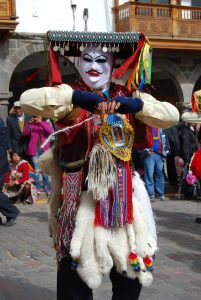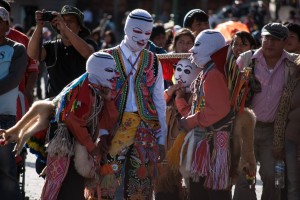Unity and Fighting, the Qhapaq Qollas of Qoyllur Rit’i.

Dancers from one of the troupes making up the Nación Tawantinsuyo will gather every night this week to the side of the Compañía church on Cuzco’s Plaza de Armas. After the seven pm mass (6 pm on Friday) in this church which has a long history with the Inca families in Cuzco, the dancers who will be climbing up the glacier and image of Christ of Qoyllur Rit’i, will carry out their very meaningful dances as part of the lead up to the pilgrimage. On Saturday they will make their way to the mountain.
Monday night a Qhapaq Qolla troupe performed. While there is much to this dance that represents the highland llama and alpaca herders and their role in Cuzco life, here I want to just discuss one aspect of last night’s dance.
Their songs are powerful, as are their costumes, movements, and the broader context of their dance in Inca and Cuzco history. But that night I was struck by a bit of Andean dualism.
The images of Christ belonging to the majordomos, the sponsors of the troupe, were sitting against the chapel and formed part of the dance when a couple of young men would dance forward arm and arm and bow before them. The men would then retreat.
They now took long slings and would snap them in turn against each other’s legs and ankles. The force of the impact could easily have drawn blood, although the dancers mostly attempted to dissemble the pain from the blows.

The maqta figure, an Andean clown and disciplinarian, would dance in between them, sometimes throwing himself in the middle, at which point the two men who had been trading cutting snaps to each other’s legs would stop. They would embrace and dance in solidarity and unison until the music would change and they would draw apart again. Once again they would fight.

This violence against each other, with the potential of drawing blood, is common in Cuzco’s traditional dances as it is in the iconography found in religious paintings. The armed angels, with arquebuses and swords, representing the sky, fight day in and day out with the earth, represented by a snake of dragon.
Teresa Gisbert insists that this battle is un-winnable and that the point is the endless contest, like the young men painfully and sharply whipping each other, one after the other, over and over, in time with the beat of the band.
Unlike Gisbert’s Angel and demon, locked in endless contest, these boys would be disciplined by the social force, the clown (maqta), at which point they came together and unity, friendship ensued.
This dance did not emphasize the distinction between men and women which can be seen as a kind of endless struggle like that of sky and earth. Instead it was a dualism of solidarity and fighting, one after the other among two men.
This gender was the focus and the message for men in Cuzco. It displayed a paradigm of friendship which is very important among men. Instead of friendship we could also simply say brotherhood—the waiqey said frequently in Cuzco—or ayni reciprocal relationships.
The fight was constrained by reciprocity, any. It was not a war of all against all, but marked the differences and tensions between people in the same category, men, and how they were regulated by the onlookers and the maqta.
When the men were in unity, separate but the same, they presented themselves before the images of Christ. Thought they fought in a scene which the Christ figures watched like the other spectators, still it was only once the were disciplined and brought together that they went before the powerful religious images of Christ.
These images of Christ are of the Lord of Qoyllur Rit’i, who according to his story, appeared as a golden child to play with a peasant boy out herding livestock alone in the high wild lands called puna, where the Qolla are from.
Known for being strong, wild, and fierce—bravos—like the harsh grass of the highlands, the Qollas make an imposing figure who also models the spinning of thread in their hands. They bring civilization represented in cloth, as a result, not unlike the Christ figure to whom the union of society is presented, even though the individuals suffen tension and conflict, not unlike the threads in a cloth whose tensions keeps the weaving together.
It is said the golden child would appear to play with the shepherd boy. They became friends, although of different origin and look yet they were unified by being boys in highland pastures and they played.
Though the shepherd did not pay attention to his flock, since he was busy playing with the other boy, still his herd reproduced and grew, causing interest among adults. They wanted to come out and trap the golden boy who obviously brought this miracle of fertility to their livestock
They could not catch him and instead found his image miraculously on a rock at the food of a massive glacier near the mountain’s top. Out of this miracle developed the official pilgrimage to Qoyllur Rit’i even though the Catholic story is only part of the history of the shrine.

Yet in this story we find a paradigm replayed in the dance of the Qhapaq Qolla, the paradigm of friendship among boys or men coming out of tension and difference in a way that leads to greater fertility and reproduction. Out of any comes wealth and growth, though people do not quit being different and do not stop having tensions and fights.
In her Foxboy, anthropologist Katherine Allen discusses the friendship between the golden boy and the sheepherder. She says in chapter five that it emphasizes the union of two, not unlike the distinct strands twined together to make thread or yarn. The Golden boy appears like an ancestor and then disappears, something that gives force to the image and idea of Christ.
This is like the doubling the Incas had between their physical bodies and the image that represented them, their wauqi. This is the same word to describe friendship or brotherhood in Cusco, way and relates to another common slang expression for friends, causita, that is so close they are like the layers in a causa, a potato terrine. Allen also sees this as the union of a whole community, when the two moieties, halves, come together. They are formally same,e ben though locked in struggle.
That same Monday, a man from Ccatcca who dances Qhapaq Qolla for his community and will be climbing up the mountain to Qoyllur Rit’i with the troupe mentioned that in his community the two haves twine a thick cord and then gather and each half pulls on a different end. If the upper moiety wins they say it means they will have a good agricultural year, while if the lower moiety wins it will be a bad one. This custom ties the struggle, the competition among brothers into fertility and, we can also say, play.




